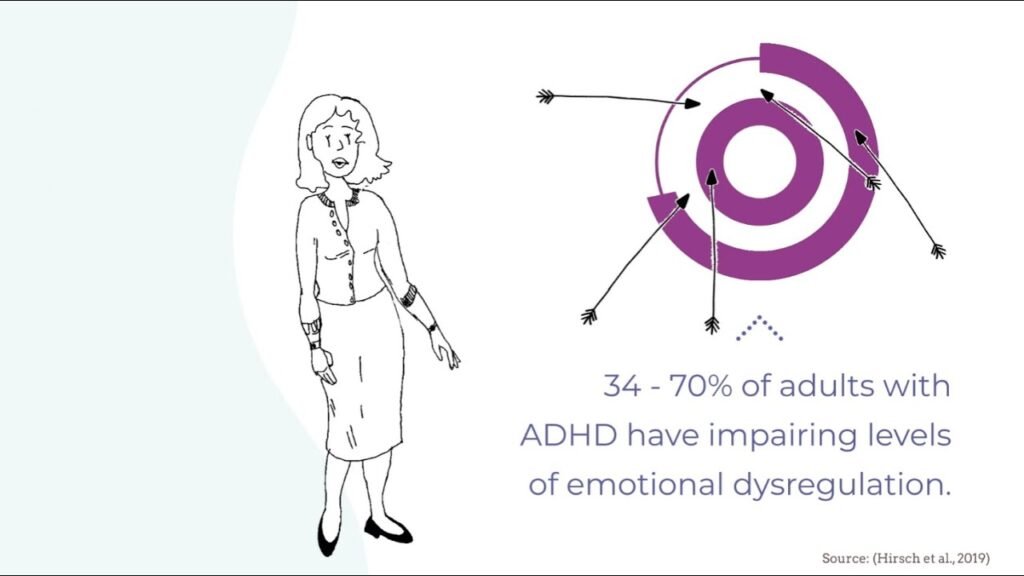Emotional dysregulation is a common but often misunderstood challenge for individuals with ADHD. Characterized by intense, overwhelming emotions that can feel difficult to control, ADHD emotional dysregulation impacts relationships, work, and everyday life. For those navigating this aspect of ADHD, understanding its roots and implementing effective strategies can make a significant difference. This article explores practical tips and approaches to help manage ADHD emotional dysregulation, empowering individuals to regain balance and improve their emotional well-being.
What is ADHD Emotional Dysregulation?
ADHD emotional dysregulation refers to the difficulty individuals with ADHD experience in managing their emotions effectively. This often manifests as intense emotional reactions, difficulty calming down after an upset, and challenges in understanding or expressing feelings appropriately. Unlike typical emotional fluctuations, emotional dysregulation in ADHD is more pronounced and can significantly impact a person’s daily life, relationships, and overall well-being.
The root of emotional dysregulation in adhd lies in the neurological differences associated with ADHD. The prefrontal cortex, the part of the brain responsible for executive functions like impulse control and emotional regulation, often operates differently in individuals with ADHD. As a result, they may struggle to process and regulate their emotions in a balanced way.
Common signs of ADHD emotional dysregulation include sudden outbursts of anger or frustration, overwhelming sadness, or extreme sensitivity to criticism. These emotional responses may seem disproportionate to the triggering event, leading to misunderstandings or strained relationships.
Recognizing ADHD emotional dysregulation is the first step toward managing it. By understanding its neurological basis and impact, individuals can seek effective strategies and support systems to better regulate their emotions and lead more fulfilling lives.

The Connection Between ADHD and Emotional Dysregulation
The relationship between ADHD and emotional dysregulation is deeply rooted in the neurological and behavioral traits associated with attention deficit hyperactivity disorder. ADHD affects the brain’s executive functions, which include the ability to regulate attention, impulses, and emotions. Emotional dysregulation is often a byproduct of these executive function challenges, making it a common struggle for individuals with ADHD.
Neurological Basis of ADHD Emotional Dysregulation
The prefrontal cortex, which governs self-control, decision-making, and emotional regulation, operates differently in individuals with ADHD. This can lead to difficulty managing emotional responses. For example, a minor inconvenience might trigger an outsized emotional reaction, or it may take significantly longer for an individual to recover from feelings of frustration or sadness. ADHD emotional dysregulation is not simply about “overreacting”; it reflects the brain’s struggle to process and regulate emotions effectively.
Behavioral Manifestations
ADHD emotional dysregulation often presents as impulsive emotional reactions, difficulty shifting focus away from negative feelings, and sensitivity to perceived rejection or criticism. These patterns can affect relationships, work performance, and self-esteem. Emotional dysregulation in ADHD doesn’t just cause discomfort—it can create real-life challenges in navigating social and professional situations.
A Reciprocal Relationship
Interestingly, ADHD and emotional dysregulation can feed into one another. The frustrations caused by ADHD symptoms—such as difficulty focusing, managing time, or completing tasks—can heighten emotional dysregulation. Conversely, emotional dysregulation can exacerbate ADHD symptoms, as heightened emotional states can further impair focus and impulse control.
Understanding this connection highlights the importance of addressing both ADHD and emotional dysregulation together. Effective strategies, such as mindfulness, therapy, and lifestyle adjustments, can significantly improve emotional regulation and help individuals with ADHD better manage the challenges they face.
Read Also : Managing ADHD Depression Together: 10 Steps Guide
Signs and Symptoms of ADHD Emotional Dysregulation

ADHD emotional dysregulation can manifest in various ways, affecting how individuals experience, express, and manage their emotions. These signs often go beyond typical emotional fluctuations, creating challenges in daily life, relationships, and self-esteem. Below are some of the most common signs and symptoms:
1. Intense Emotional Reactions
Individuals with ADHD emotional dysregulation often experience emotions more intensely than others. A minor frustration, such as a delayed response to a text, can provoke significant anger or sadness. These reactions may seem disproportionate to the triggering event.
2. Difficulty Calming Down
Once emotions are triggered, individuals with ADHD may struggle to return to a baseline state of calm. This prolonged emotional intensity can interfere with daily activities and decision-making.
3. Mood Swings
Rapid and unpredictable changes in mood are a hallmark of ADHD emotional dysregulation. Someone may shift from happiness to frustration or sadness in a matter of moments, often without a clear cause.
4. Sensitivity to Criticism
Many individuals with ADHD are highly sensitive to perceived rejection, criticism, or failure. This sensitivity can lead to feelings of shame, inadequacy, or defensiveness, further amplifying emotional dysregulation.
5. Impulsive Emotional Responses
Impulsivity in ADHD isn’t limited to actions—it extends to emotions as well. Emotional outbursts, such as yelling or crying, can occur suddenly and without much forethought, creating tension in personal and professional relationships.
6. Difficulty Identifying and Expressing Emotions
Emotional dysregulation often includes alexithymia, or difficulty identifying and articulating emotions. This can lead to frustration when trying to communicate feelings, further complicating relationships and self-awareness.
7. Persistent Negative Thoughts
Individuals with ADHD emotional dysregulation may find it challenging to move past negative feelings. They might ruminate on past mistakes, perceived injustices, or worries, which can exacerbate emotional difficulties.
8. Physical Symptoms
Intense emotional experiences can sometimes lead to physical symptoms like headaches, fatigue, or stomachaches, as the body responds to prolonged stress or heightened emotions.
Recognizing these signs of ADHD emotional dysregulation is crucial for managing its impact. With the right tools—such as therapy, mindfulness techniques, and emotional regulation strategies—individuals can learn to better navigate their emotions and improve their quality of life.
Why ADHD Emotional Dysregulation Happens: Understanding the Brain
ADHD emotional dysregulation is deeply tied to how the brain processes and regulates emotions. The neurological differences associated with ADHD affect the areas of the brain responsible for executive functions, leading to challenges in controlling emotional responses. Understanding these brain mechanisms provides valuable insight into why emotional dysregulation is so prevalent in individuals with ADHD.
1. The Role of the Prefrontal Cortex
The prefrontal cortex, located at the front of the brain, is the control center for executive functions such as decision-making, impulse control, and emotional regulation. In individuals with ADHD, this area often has reduced activity or connectivity, impairing its ability to manage emotional responses. This explains why individuals with ADHD emotional dysregulation may react more intensely to situations or have difficulty calming down after an emotional trigger.
2. The Limbic System’s Overactivity
The limbic system, which governs emotions and memory, can become overactive in ADHD. When emotions like anger, frustration, or sadness are triggered, the limbic system may amplify these feelings. Without sufficient regulation from the prefrontal cortex, these emotions can spiral out of control, leading to heightened and prolonged reactions.
3. Dopamine Dysregulation
Dopamine, a neurotransmitter critical for motivation and reward processing, plays a significant role in ADHD. Lower dopamine levels in the brain can make it harder for individuals to experience emotional satisfaction or regulate their emotional states. This contributes to the impulsivity and mood swings often seen in ADHD emotional dysregulation.
4. Impaired Emotional Self-Regulation Pathways
In ADHD, the neural pathways that connect the prefrontal cortex to the amygdala (the brain’s emotional center) may function less efficiently. This impairment disrupts the brain’s ability to assess emotional stimuli rationally, leading to impulsive and exaggerated responses.
5. Delayed Maturation of Brain Regions
Research has shown that certain brain regions in individuals with ADHD develop more slowly than in neurotypical individuals. This delay can impact emotional regulation abilities, making it harder for individuals with ADHD to process and control emotions effectively as they grow.
6. Stress and Environmental Factors
External stressors, such as demanding environments or social challenges, can exacerbate ADHD emotional dysregulation. When combined with the brain’s inherent challenges in regulating emotions, these factors can make emotional outbursts or prolonged distress more common.
Conclusion
ADHD emotional dysregulation is not simply a lack of emotional control but a reflection of underlying neurological differences. By understanding the brain’s role in these challenges, individuals with ADHD can work toward strategies, therapies, and tools that support better emotional regulation, ultimately improving their quality of life.
Practical Tips for Managing ADHD Emotional Dysregulation
Managing ADHD emotional dysregulation can be challenging, but with the right strategies and tools, it’s possible to improve emotional balance and control. Here are practical tips to help navigate the intense emotions often associated with ADHD:
1. Practice Mindfulness and Meditation
Mindfulness techniques, such as meditation or deep breathing exercises, can help individuals with ADHD emotional dysregulation pause and assess their emotions before reacting. These practices train the brain to focus on the present moment and reduce the intensity of emotional responses over time.
2. Develop Emotional Awareness
Understanding your emotions is the first step to managing them. Journaling about daily experiences and feelings can help identify triggers and patterns. By recognizing what causes emotional dysregulation, you can take proactive steps to avoid or address those triggers.
3. Use Grounding Techniques
When overwhelmed, grounding exercises like naming five things you can see, four you can touch, three you can hear, two you can smell, and one you can taste can bring your focus back to the present and calm intense emotional states.
4. Implement Regular Exercise
Physical activity releases endorphins and stabilizes mood. Activities like yoga, walking, or high-intensity workouts can help manage ADHD emotional dysregulation by improving overall emotional resilience.
5. Create a Routine
Having a structured daily routine can minimize stress, a common trigger for emotional dysregulation. Planning your day, including time for rest and relaxation, can create a sense of stability and control.
6. Practice Cognitive Behavioral Techniques
Cognitive Behavioral Therapy (CBT) provides tools to challenge negative thought patterns and reframe emotional responses. Learning to question and replace irrational thoughts with balanced ones can significantly reduce emotional dysregulation.
7. Communicate with Support Networks
Sharing your challenges with trusted friends, family, or a therapist can provide emotional support and perspective. Building a support system ensures you’re not navigating ADHD emotional dysregulation alone.
8. Use Emotional Regulation Apps
Technology can offer helpful tools for tracking and managing emotions. Apps designed for emotional regulation can provide reminders to take breaks, log emotions, or practice calming techniques throughout the day.
9. Practice Self-Compassion
It’s important to recognize that ADHD emotional dysregulation is not a personal failing. Be kind to yourself when you experience emotional challenges, and celebrate small victories in your journey toward better regulation.
10. Seek Professional Help When Needed
Sometimes managing ADHD emotional dysregulation requires professional support. Therapists, counselors, or psychiatrists can provide tailored strategies, therapy sessions, or medication to help address emotional challenges.
Conclusion
With persistence and the right strategies, individuals with ADHD can develop better control over their emotional responses. By combining practical techniques with support systems, it’s possible to manage ADHD emotional dysregulation effectively and enhance overall emotional well-being.
Building Healthy Habits to Improve Emotional Control
Developing healthy habits can significantly enhance emotional control, especially for individuals struggling with ADHD emotional dysregulation. These habits create a foundation of stability, resilience, and balance, making it easier to navigate intense emotional experiences. Here are some actionable ways to build healthy habits for better emotional regulation:
1. Prioritize Sleep Hygiene
Adequate sleep is essential for emotional regulation. Poor sleep can exacerbate ADHD symptoms and emotional dysregulation. Establish a consistent bedtime routine, avoid screen time before bed, and create a relaxing sleep environment to improve the quality of your rest.
2. Maintain a Balanced Diet
Nutrition plays a crucial role in emotional health. Incorporate foods rich in omega-3 fatty acids, lean proteins, and complex carbohydrates to support brain function and mood stability. Avoid excessive sugar and caffeine, which can cause mood swings and worsen emotional dysregulation.
3. Stay Physically Active
Regular exercise is a powerful tool for managing emotions. Activities like running, swimming, yoga, or even walking release endorphins, reduce stress, and improve mood stability. Aim for at least 30 minutes of physical activity most days of the week.
4. Establish a Routine
Having a structured daily routine can reduce uncertainty and stress, both of which can trigger emotional dysregulation. Incorporate time for work, leisure, exercise, and relaxation, ensuring balance in your daily activities.
5. Practice Stress-Reduction Techniques
Adopt habits like deep breathing, progressive muscle relaxation, or meditation to manage stress. These techniques can help calm the nervous system and prevent emotional outbursts.
6. Limit Screen Time
Excessive screen time, especially on social media, can overstimulate the brain and negatively impact emotional health. Set boundaries for digital consumption and prioritize activities that promote relaxation and mindfulness.
7. Develop Effective Time Management Skills
Feeling overwhelmed by tasks can lead to frustration and emotional dysregulation. Use tools like planners, to-do lists, or apps to manage your time effectively and reduce stress caused by procrastination or disorganization.
8. Cultivate Positive Relationships
Surround yourself with supportive and understanding individuals. Positive social connections can provide emotional stability, encouragement, and a safe space to express feelings.
9. Practice Gratitude
Daily gratitude practices, such as journaling about things you’re thankful for, can shift your focus to positive aspects of life. This habit can improve mood and foster a sense of emotional balance.
10. Engage in Creative Outlets
Creative activities like painting, writing, or playing music can help process and release emotions in a healthy way. These outlets provide an opportunity for self-expression and emotional relief.
Conclusion
Building healthy habits is a proactive way to improve emotional control and reduce the impact of ADHD emotional dysregulation. By integrating these practices into your daily life, you can create a strong foundation for emotional stability and resilience, enhancing both your mental health and overall quality of life.


